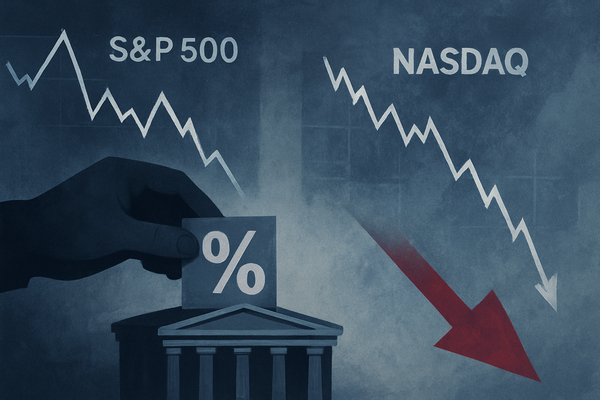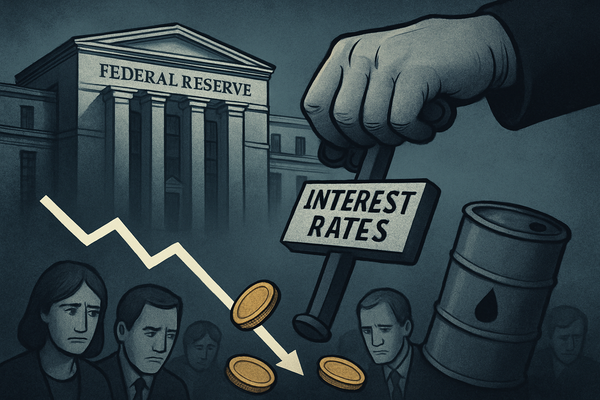Federal Reserve Grapples with Stubborn Inflation, Casting Doubt on Future Rate Cuts

Federal Reserve policymakers are increasingly voicing concerns that the progress made in taming inflation could slow or even stall, creating a significant hurdle for the highly anticipated path of interest rate cuts. As of November 14, 2025, a palpable division has emerged within the Federal Open Market Committee (FOMC), with many officials prioritizing the long-term goal of price stability over further monetary easing. This cautious stance, underscored by recent economic data and hawkish statements, suggests that the era of rapidly declining interest rates may be further off than market participants had hoped, posing fresh challenges for businesses and consumers alike.
The immediate implication of this apprehension is a cloud of uncertainty hanging over the December 2025 FOMC meeting and the outlook for early 2026. While the Fed has delivered two 25-basis-point cuts in September and October, bringing the federal funds rate to 3.75-4.00%, the internal debate signals a potential pause or even a prolonged period of holding rates steady. This shift in sentiment reflects a deep-seated worry that inflation, after years of elevated levels, could become entrenched, requiring a more sustained restrictive monetary policy to bring it back to the central bank's 2% target.
Detailed Scrutiny: The Fed's Battle Against Persistent Price Pressures
The current trepidation among Federal Reserve policymakers is rooted in several key factors, most notably the persistent elevation of inflation above the 2% target, a situation that has now stretched for nearly five years. Minutes from recent FOMC meetings, including those in August and October 2025, explicitly highlight participants' concerns about upside risks to the inflation outlook. Staff projections in October 2025 reinforced this, suggesting that the projected rise in inflation this year might prove more stubborn than initially anticipated.
A significant contributor to these price pressures is the impact of tariffs, which policymakers note are becoming "more apparent in the data," particularly affecting goods inflation. While some officials debate whether these effects are merely masking underlying trends, others fear that businesses are increasingly passing these costs onto consumers, transforming a temporary bump into a more sustained inflationary force. Beyond tariffs, broader price pressures, including rising healthcare costs, insurance premiums, and electricity prices, are also frequently cited by policymakers as concerns. Perhaps the most critical worry is the potential for persistent inflation to unanchor inflation expectations. Atlanta Fed President Raphael Bostic, in early November 2025, cautioned that if expectations drift upward and begin to influence price-setting behaviors, it could lead to higher long-run inflation. Kansas City Fed President Jeff Schmid echoed this sentiment, warning against complacency and the risk of ingrained inflation making the return to target "more difficult and costly."
Recent economic data presents a mixed, and therefore complex, picture. The annual Consumer Price Index (CPI) rose to 3% in September 2025, up from 2.9% in August. Core CPI, which excludes volatile food and energy prices, stood at 3% in September, a slight decrease from 3.1% in August. The Fed's preferred inflation gauge, the Personal Consumption Expenditures (PCE) Price Index, showed headline inflation at 2.7% and core PCE at 2.9% in August 2025. The Federal Reserve Bank of Atlanta's Sticky-Price CPI, a measure of prices that change slowly, reached 3.3% in September 2025. These figures, while showing some moderation, are still above the Fed's target, fueling the debate. The FOMC's recent rate cuts in September and October were not unanimous, with the October vote seeing Kansas City Fed President Jeffrey Schmid dissenting, preferring to hold rates steady, and Fed Governor Stephen Miran advocating for a larger 50-basis-point cut, underscoring the deep divisions within the committee.
Corporate Crossroads: Winners and Losers in a Higher-for-Longer Environment
The Federal Reserve's cautious stance on interest rate cuts has significant implications for various sectors and public companies, creating both potential winners and losers in a "higher-for-longer" interest rate environment. Companies with strong balance sheets, ample cash reserves, and less reliance on debt financing are generally better positioned to weather this period. Conversely, highly leveraged companies, particularly those in interest-sensitive sectors, may face increased financial strain.
Financial institutions, especially large banks like JPMorgan Chase & Co. (NYSE: JPM) and Bank of America Corporation (NYSE: BAC), could potentially benefit from a prolonged period of higher interest rates. A steeper yield curve, where long-term rates are significantly higher than short-term rates, often allows banks to earn more on their lending activities while paying relatively less on deposits, thereby expanding their net interest margins. However, if economic growth slows significantly due to restrictive policy, loan demand could decrease, offsetting some of these benefits. Insurance companies, which often invest premiums in fixed-income assets, could also see improved returns on their portfolios over time.
Conversely, sectors heavily reliant on borrowing for growth or consumer spending sensitive to financing costs are likely to face headwinds. The real estate sector, including homebuilders like D.R. Horton, Inc. (NYSE: DHI) and commercial real estate developers, could experience a slowdown as higher mortgage rates and development loan costs deter buyers and investors. Technology companies, particularly those in growth stages that rely on venture capital or debt for expansion, might find it more expensive to secure funding, potentially impacting their valuation and expansion plans. Retailers and consumer discretionary companies, such as Target Corporation (NYSE: TGT) or Starbucks Corporation (NASDAQ: SBUX), could see reduced consumer spending as higher interest rates translate to increased costs for credit card debt and auto loans, squeezing household budgets.
Furthermore, companies with significant foreign currency exposure could be impacted by a stronger U.S. dollar, which often accompanies higher domestic interest rates. A stronger dollar makes U.S. exports more expensive and imports cheaper, affecting the competitiveness of multinational corporations. Companies with substantial debt coming due in the near term will also face refinancing risks at potentially higher rates, increasing their interest expenses and potentially impacting profitability. Investors will be closely watching corporate earnings reports for signs of how companies are managing their debt loads and adapting to the evolving interest rate landscape.
Wider Significance: Unpacking Broader Economic Currents
The Federal Reserve's current dilemma regarding inflation and interest rates extends far beyond the immediate financial markets, touching upon broader economic trends, regulatory implications, and historical precedents. The ongoing debate highlights the challenging trade-off between the Fed's dual mandate of achieving price stability and maximum employment. While the labor market has shown some signs of softening, with slower job gains and a slight uptick in the unemployment rate, key officials like Cleveland Fed President Beth Hammack and Atlanta Fed President Raphael Bostic view inflation as the more pressing concern. The fear is that premature reductions in interest rates to mitigate employment risks could inadvertently reignite inflationary pressures, undoing years of monetary tightening.
This cautious approach also fits into a broader global trend where central banks worldwide are grappling with persistent inflation in the wake of supply chain disruptions, geopolitical tensions, and shifting consumer demands. The impact of tariffs, frequently cited by Fed officials, underscores the complex interplay between trade policy and monetary policy. Should these tariffs persist or escalate, they could continue to act as an inflationary force, complicating the Fed's efforts to achieve its 2% target. The ripple effects of a "higher-for-longer" rate environment are extensive, impacting not only businesses but also average consumers who face higher borrowing costs for mortgages, auto loans, and credit card debt. This can lead to a slowdown in consumer spending, which is a major driver of economic growth.
Regulatory and policy implications are also at play. The recent government shutdown, which delayed the release of crucial official economic data, including October's CPI and jobs reports, further complicates the Fed's decision-making process. The lack of comprehensive, up-to-date data creates an environment of increased uncertainty, potentially reinforcing the argument for a more patient approach to rate cuts until a clearer economic picture emerges. Historically, periods of persistent inflation, such as the 1970s, serve as a stark reminder of the challenges central banks face in re-anchoring inflation expectations once they begin to drift. Policymakers are keenly aware of these precedents and are determined to avoid a repeat, even if it means maintaining a tighter monetary policy for longer than some market participants would prefer. The conclusion of the FOMC's balance sheet reduction on December 1, 2025, adds another layer to the evolving monetary policy landscape, signaling a shift in how the Fed manages its overall policy stance.
The Road Ahead: Navigating an Uncertain Economic Landscape
Looking ahead, the immediate future for interest rates remains highly uncertain, with a strong possibility that the Federal Reserve will maintain its current federal funds rate target of 3.75-4.00% through the December 2025 meeting and potentially into early 2026. While fixed-income markets had previously priced in a high probability of a December cut, recent hawkish statements from Fed officials have significantly tempered these expectations. Cleveland Fed President Beth Hammack believes inflation will not reach the 2% target until a year or two after 2026, advocating for continued monetary policy leaning against inflation. Kansas City Fed President Jeff Schmid has even indicated he might dissent again if further cuts are proposed, fearing they could "ingrain higher inflation."
For businesses, this outlook necessitates strategic pivots and adaptations. Companies that have postponed capital expenditures or expansion plans in anticipation of lower borrowing costs may need to re-evaluate their strategies, potentially delaying investments further or seeking alternative financing. Those with floating-rate debt will continue to face elevated interest expenses, making robust cash flow management and hedging strategies crucial. Consumers, too, will need to adapt, potentially delaying large purchases like homes and cars, or prioritizing debt reduction in the face of sustained higher interest rates. This could lead to a more conservative spending environment, impacting sectors reliant on consumer discretionary spending.
Market opportunities may emerge in sectors that are less sensitive to interest rates or that thrive in an environment of moderate economic growth and persistent, albeit slowing, inflation. Value stocks, companies with strong dividends, and those in defensive sectors like utilities or healthcare might become more attractive. Conversely, highly speculative growth stocks, particularly those with distant profitability horizons, could face continued pressure. Potential scenarios range from a "soft landing," where inflation gradually recedes without a severe recession, to a "hard landing," where restrictive policy triggers a more significant economic downturn. The Fed's ability to navigate this narrow path will depend heavily on incoming economic data, particularly inflation readings and labor market reports, which will guide their policy decisions in the coming months.
A Comprehensive Wrap-Up: Vigilance in Volatile Times
In summary, the Federal Reserve finds itself at a critical juncture, with policymakers expressing serious concerns that the battle against inflation is far from over and that progress could slow or stall. This apprehension, fueled by stubbornly elevated price data, the impact of tariffs, and the risk of unanchored inflation expectations, has led to a significant internal debate within the FOMC. The consequence is a cautious outlook for interest rate cuts, with many officials advocating for a "higher-for-longer" approach to monetary policy, potentially delaying further easing well into 2026.
The market moving forward will likely be characterized by heightened volatility and sensitivity to economic data releases, particularly those related to inflation and employment. Investors should prepare for a period where interest rates remain elevated, impacting everything from corporate earnings to consumer spending patterns. Companies with strong financial health, diversified revenue streams, and efficient cost structures will be better positioned to navigate this environment, while those heavily reliant on cheap credit or discretionary consumer spending may face ongoing challenges.
The lasting impact of this period could redefine economic expectations, emphasizing the importance of fiscal prudence and resilience in the face of persistent inflationary pressures. What investors should watch for in the coming months are not just the Fed's official statements, but also the nuanced speeches and interviews from individual FOMC members, which often provide early signals of shifts in policy sentiment. Key economic indicators, including monthly CPI and PCE reports, employment figures, and consumer confidence surveys, will be paramount in shaping the Fed's decisions and, by extension, the trajectory of the financial markets. The vigilance of both policymakers and market participants will be crucial in deciphering the path ahead.
This content is intended for informational purposes only and is not financial advice



